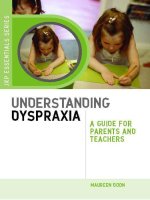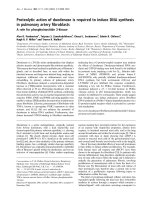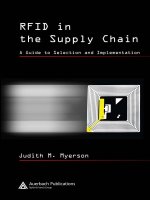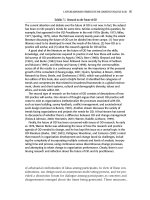HOW TO SUCCEED IN SCHOOL AND UNIVERSITY - A GUIDE FOR PARENTS AND STUDENTS pot
Bạn đang xem bản rút gọn của tài liệu. Xem và tải ngay bản đầy đủ của tài liệu tại đây (446.51 KB, 55 trang )
HOW TO SUCCEED IN SCHOOL AND
UNIVERSITY
A GUIDE FOR
PARENTS AND
STUDENTS
By Michael Petty, PhD
i
About the Author
Dr. Michael Petty PhD is The Senior Scientist at
www.NeuroLearnings.com
He has a BA from Durham University, UK
An MA from the University of Calgary and
A PhD from the University of Wisconsin at Madison
After National Service in the British Army where he was a
marksman, and a stint as a pilot in the RAF, Michael was a professor and senior lecturer.
He taught and carried out research at the Centre for Educational Research at the
University of New South Wales, the University of Calgary and the University of
Wisconsin-Madison.
Michael was a Canada Council Doctoral Fellow and held other fellowships including a
Shaw Fellowship at the University of Wisconsin-Madison. He also achieved a 4.0 grade
point average. He is the author of over thirty papers and books and numerous articles in
professional journals.
Michael is the CEO of TASK Research in Australia and chairman of Lanka Statistics and
IT Research (Pvt.) Ltd, an international company based in Colombo, Sri Lanka. He was
principal of S.M.A.R.T Research in Australia.
Michael is a social psychologist and applied statistician.
* The cover photo shows Diluni, a statistician who developed a conjoint analysis package which
is available on-line. That is a huge international achievement. Diluni comes from a rural area of
Sri Lanka and she studied at rural schools and a rural university. Diluni is studying for an MsC.
She uses brainwave entrainment.
ii
Contents
Chapter Content Page
Chapter 1 Myths about Teaching and Learning
1
Chapter 2 What is Intelligence?
7
Chapter 3 The IQ Fallacy and Psychological Fraud
15
Chapter 4 The Human Brain is More Powerful than a Computer
20
Chapter 5 There is no Limit to What You Can Achieve
24
Chapter 6 Learning Styles
30
Chapter 7 Effective Learning Strategies
35
Chapter 8 The Myth of Subliminal Learning
40
Chapter 9 The Way to Unlimited Success
44
Chapter 10 This is the Way to Succeed in School
47
Chapter 11 For Parents – How To Motivate Your Children
49
Chapter 12 Effective Learning Strategies For Students
51
1
This e-book helps students to achieve
success in school and university.
It dispels the myth that some people are
born no-hopers, as Australians say.
We show that everyone can achieve success in school and
we show students and the parents of students how to foster
high levels of achievement.
Myths about Teaching and Learning
Surprisingly, a lot of educators know little about learning. And when they
do, what they know does not always find its way into schools.
An example: people have believed for at least half a century that a foreign
language is best learned at a young age. Yet in schools in the USA and
Australia a foreign language was not taught until high school. This seemed
counterproductive if not outright stupid. Now evidence starts to emerge that
perhaps we had no idea of when it is best to teach languages.
New research shows:
It is a common belief that younger children learn second languages more easily
and more rapidly than both adolescents and adults. Implicit in decisions to lower
the age of first instructional exposure to an additional language is also the belief
that the greater the number of years of academic study devoted to foreign
language learning, the better the outcomes.
However, there is surprisingly little research evidence to support these beliefs. …
Research is therefore needed to inform policy makers of the respective advantages
of an early start and different time distributions as well as of the different ways in
which age may affect proficiency.
1
1
Carmen Muñoz, Laura Collins, Joanna White, Mia Victori Blaya, Maria Rosa Torras Cherta, Teresa
Navés, Luz Celaya Age, intensity of instruction, and metalinguistic awareness in EFL
learning, (extracted 16th September 2010)
2
Perhaps foreign language instruction in US and Australian schools was
based on misinformation. Chances are that it still is.
Unfortunately a lot of educational practices are based on myths and fads.
New theories about teaching and learning spring up like mushrooms after
rain.
What we aim to do in this e-Book is to reveal some of the more pervasive
myths and to provide real information based on good research.
Robert A. Bjork, a psychologist at the University of California, Los Angeles,
speaking about current research into learning says:
“We have known these principles for some time, and it’s intriguing that schools
don’t pick them up, or that people don’t learn them by trial and error … Instead,
we walk around with all sorts of unexamined beliefs about what works that are
mistaken.”
It is particularly distressing that so many educators are misinformed about
learning. This makes it very difficult for students to know how to succeed in
school. We are all students, and some of us are parents of students, at some
time in our lives. We need to know more about how to learn effectively.
Our goal in this e-Book is to provide parents and students with solid
information on how to succeed in school and university.
Student Motivation
Washington Post economics columnist Robert Samuelson asked why
America has spent so much money on school reform and yet has so little to
show for it. The answer he said lies not necessarily with schools and
teachers, rather:
“The larger cause of failure is almost unmentionable: shrunken student motivation, …
The unstated assumption of much school ‘reform’ is that if students aren’t motivated, it’s
mainly the fault of schools and teachers.” Wrong. “Motivation is weak because more
students (of all races and economic classes) don’t like school, don’t work hard and don’t
do well.”
3
It is easier for politicians and policy makers to blame teachers than to blame
parents or students.
How Motivation Overcomes Disadvantage
One cause of student failure, then, is poor motivation. Fortunately cognitive
science can help develop motivation.
Years ago a friend and colleague at the University of New South Wales, Dr.
Phil Mead, did some interesting research that showed that the children of
non-English speaking immigrants to Australia performed better in school
than their native-born Australian peers. The way Dr Mead explained this
was to hypothesize that immigrants are more highly motivated to succeed
than others, which is why they take the major leap into the unknown that
immigration implies, severing ties with all they knew and left behind them.
Immigrants passed their motivation on to their children, Dr Mead postulated,
and it was this high motivation that enabled them to overcome disadvantages
such as low social status and their parents’ lack of an English language
education. And this motivation was great enough to propel them well
beyond what their teachers expected of them. It was ambition and
motivation, not greater intelligence, which propelled these children from
immigrant families to achieve in school and university at a level beyond
their native-born Australian peers.
There is a great deal of evidence that parents’ attitudes and support and
encouragement have more impact on students’ performance in school than
any other factor, including IQ and teacher aptitude.
The Secrets of Success in School
Research shows that you can beat the odds. In the USA, Canada and
Australia Asian students outperform others as if they had an IQ advantage of
10 points, though of course they do not. What is their secret? The answer
can be expressed in four words: ambition, confidence, hard work. It is the
ambition that drives the hard work. It is confidence that makes the hard work
successful.
4
• You must want to succeed, and
• You must know that you can succeed.
How Parents can Help Their Children Succeed in School
Education is important; it is a major determinant of life chances. But
education is not a given, parents can do much to foster educational
achievement in their children.
• First parents need to know that every child has the potential for
educational success. Your children almost certainly have the ability to
succeed in school. There are common stereotypes about educational
achievement that are false, such as that girls are not as good at mathematics
or science or engineering as boys, or that the daughter of a single mother
who works as a hospital cleaner cannot aspire to become a brain surgeon.
These stereotypes are dangerous myths and as a parent you have to examine
whether you believe them. If you do believe them you need to re-examine
your beliefs. Social class is a better predictor of performance in school than
IQ; this is because working class parents and teachers believe that working
class children are less likely to succeed in school than middle class children.
But Asian children in North America and Australia succeed in school not
because they are intellectually or socially superior to Americans, Canadians
or Australians of European origin, but because they are more highly
motivated to succeed. It is the motivation and the belief that they can
succeed that result in them topping university entrance exams and university
courses year after year. And the motivation is provided by their parents.
As Professor Phil Mead showed in Australia, the children of non-English
speaking immigrant parents perform better in school than their native
Australian peers despite the fact that they are from disadvantaged working
class families, because they inherit their parents’ will to achieve.
Teachers often, unfortunately, propagate the myth of working class
disadvantage, giving working class or minority children in their care the idea
that they should not aspire to higher occupations.
5
I knew this in theory but I came across it face to face when I went with my
family to Australia to teach at university. At first, my son attended a working
class school and his teacher, assuming he came from a working class
background similar to that of the other students in the school, advised him
that his career aspirations should not include anything higher than a trade or
driving a truck. I went and had words with that teacher. Our son went on to
win a university medal.
There are role models such as President Obama which show that such
stereotyping is wrong. Introduce your child to appropriate role models – you
do not have to like President Obama to present him as a role model, he is an
African American from a single parent family who became a Harvard
professor and president against the odds. Your child too can beat the odds,
with your help.
• Parents need to foster a winning attitude in their children. They have
to convince their children that they can succeed. It is the subconscious mind
that needs to know this and the subconscious mind is negative and difficult
to access. There are certain principles that derive from mental programming
that should be followed in encouraging your child:
• Provide role models for educational achievement. You, your child and
his teachers must not think that working class, African, Hispanic, or poor
children cannot succeed in school. This is untrue. There are plenty of
people from disadvantaged backgrounds that have achieved in school
against the odds. Look for such role models.
• Make goals realistic. Encourage your child to aim for the top ten percent
of his or her class in mathematics, not necessarily for the top position.
• Ignore the problem – focus on the solution. Do not for instance say
‘you must not watch TV while doing homework’. Avoid negatives, be
positive; say ‘do your homework in a place free of distractions’, and
name that place. Set aside an area where the child can do homework free
of the distractions of TV.
• Repetition. Advertisers know the value of repetition. Repeat your mental
programming even after the rules seem to have been learned, this will
reinforce desirable behaviors and attitudes.
6
• Keep it simple. Do not try to achieve everything at once. And keep your
instructions and advice simple, simple words will be processed more
rapidly by the subconscious mind.
• Belief and confidence. Believe in the abilities of your child and yourself
and have confidence in them. The human mind is infinitely powerful and
it has few limitations. If you have confidence in the ability of your child
to achieve then you will instill that confidence in your child also, and
your child will achieve what he or she believes he or she can achieve.
• Hire a tutor if you feel you must. If you can afford a tutor then it may
be a good thing to hire one, but it is probably not necessary as long as
your child has the learning materials they need. And having a tutor may
give your child the idea that they are less than competent, otherwise why
do they need a tutor?
• Meditate. Learn meditation with your children, it will benefit both you
and them. Meditation improves mental focus and thinking in general.
Meditation is made easier with brainwave entrainment. It also improves
general health.
• Use brainwave entrainment technology. Brainwave entrainment
technology is surprisingly inexpensive and
there is plenty of university research to show
that it works. It is also simple to use. Your
child sits and studies while playing the
appropriate mp3 track on headphones or
speakers. Brainwave entrainment technology,
including will enhance the learning
experience. Brainwave entrainment can also
help with meditation. There is no risk to you, the products are
guaranteed.
7
What is Intelligence?
Often when people think of intelligence they think of IQ, but IQ is not
intelligence, it is supposedly a measure of intelligence. IQ is short for
Intelligence Quotient and in the early days of IQ testing if you asked a
psychologist what IQ tests measure they would respond with “IQ tests
measure intelligence”. Nowadays psychologists are more likely to say: “IQ
tests measure what IQ tests measure” or perhaps “IQ tests measure IQ”.
At best IQ is a measure of performance, but it is a very poor measure.
Howard Gardner has devoted his career as a psychologist to the study of
intelligence. Gardner defines intelligence as 'the capacity to solve problems
or to fashion products that are valued in one or more cultural settings'.
2
Clearly intelligence is a capacity or potential to perform, that capacity may
be measured, though imperfectly, in terms of IQ or academic tests, college
admission tests, and so on.
Howard Gardner is best known for his work on multiple intelligences. The
theory implicit in psychometric testing, is that intelligence is a single entity,
that it results from a single factor, and that it can be measured simply via IQ
tests. Gardner, however, has devoted a career in psychology to exploring the
idea that there are multiple intelligences, not a single underlying factor.
According to Gardner’s latest formulation there are seven kinds of
intelligence, they are:
Linguistic intelligence, logical-mathematical intelligence, musical
intelligence, bodily-kinesthetic intelligence, spatial intelligence,
interpersonal intelligence - understanding other people, and intrapersonal
intelligence, which is understanding oneself.
2
Howard Gardner, & Hatch, T. (1989). Multiple intelligences go to school: Educational
implications of the theory of multiple intelligences. Educational Researcher, 18(8), 4-9.
8
Whether Gardner is right and there are seven forms of intelligence is
debatable, and this is not a new debate. At the beginning of the twentieth
century London University Professor Charles Spearman studied the nature of
intelligence. At the time there was debate among scholars as to whether
there is one general underlying factor in intelligence or whether intelligence
consists of a number of factors, similar to some of those postulated by
Howard Gardner. The single underlying factor theory won out in the IQ
debate and is embodied in IQ. This led to the IQ fallacy.
There is a new IQ debate. Howard Gardner is one of the participants, Daniel
Goleman is another. Gardner is concerned with what might be called
intellectual IQ; Goleman is concerned with what he calls emotional
intelligence.
Emotional Intelligence
In his groundbreaking book Emotional Intelligence Daniel Goleman
explores recent findings in neuroscience
3
.
Goleman asserts that the thinking brain grew from the primitive emotional
brain: this, he says, reveals much about the relationship of thought to
feeling; there was an emotional brain long before there was a rational one.
(Goleman p.11) This is something like what Freud also said.
The Id and the Ego
Id, ego, and super-ego are the three parts of the
psychic apparatus defined in Sigmund Freud’s
structural model of the psyche. Freud may be
somewhat passé now, but the model is a useful
one. According to this model of the mind, the
uncoordinated instinctual trends are the id; the
organized part of the psyche is the ego. These
constructs are functions of the mind and do not
necessarily correspond to structures of the brain,
which are the concern of neuroscience.
3
Daniel Goleman, Emotional Intelligence, New York: Bantam Books, 1995
9
Freud said of the id:
It is the dark, inaccessible part of our personality, what little we know of it we have learnt
from our study of the dream-work and of the construction of neurotic symptoms, and
most of this is of a negative character and can be described only as a contrast to the ego.
We all approach the id with analogies: we call it a chaos, a cauldron full of seething
excitations
In Freud’s formulation the id is a more basic part of the mind than the ego;
thus the psyche is, at birth, an undifferentiated id, part of which then
develops into a structured ego. The id:
“
contains everything that is inherited, that is present at birth—above all, therefore,
the instincts, which originate from the somatic organization, and which find a first
psychical expression here (in the id) in forms unknown to us” Freud, (1933) New
Introductory Lectures on Psychoanalysis
The id holds the basic drives, and from the perspective of neuroscience is the
powerful unconscious mind that regulates our unconscious functions such as
breathing, heartbeat and digestion. We shall henceforth refer to Freud’s Id as
the unconscious mind. Breathing is the only unconscious function that we
can easily access consciously, which is one reason why it is so effective in
meditation to focus on the breath.
Focus on the breath in meditation gives some access to the normally
inaccessible unconscious and it may well be that the pains of the first stage
of a meditation retreat are occasioned when focus on the normally
unconscious breath brings the id/unconscious mind to the surface.
”
The unconscious mind is responsible for our basic drives such as those for
food, water and sex; it is home to our basic impulses. The unconscious mind
is amoral, totally selfish, concerned only with pleasure and pain. The
unconscious mind has no sense of time, it is completely illogical, sexual,
infantile in its emotional development, and is not able to take “no” for an
answer. The unconscious mind is regarded as the home of the libido.
The mind of a psycho/sociopath never develops beyond the unconscious
mind, which is why sociopaths remain completely self-centered asocial
people, entirely lacking in conscience even into adulthood. They are
singularly focused on getting what they want for themselves and do not care
at all about the cost to anyone else. In this they are pure unconscious mind.
10
The unconscious mind is enormously powerful, as Freud said:
The ego is that part of the id which has been modified by the direct influence of the
external world The ego represents what may be called reason and common sense, in
contrast to the id, which contains the passions in its relation to the id it is like a man on
horseback, who has to hold in check the superior strength of the horse.
The sociopath does not develop a functioning ego and though many of them
learn to behave superficially as social beings they cannot sustain long-term
relationships even with family.
As Freud’s parable of horse and rider suggests the unconscious mind is
passionate and more powerful than the ego. The reason why smokers have
so much difficulty quitting and fat people stopping snacking is that the
unconscious mind demands the pleasures of smoking and food.
Though the more rational ego knows that smoking is self destructive and
that obesity kills it has little chance of imposing its will to quit upon the
unconscious mind because the unconscious mind is powerful and emotion
over-rides reason every time. If the unconscious wants to smoke then it will
be very difficult to quit, even though the rational conscious mind desperately
wants to.
Mister Spock of Star Trek may have been completely rational but he was
part Vulcan, humans are not completely rational; the primitive part of our
brain ensures that.
The pain of meditation
There were more than sixty people on a Vipassana meditation retreat in
Australia’s Blue Mountains. It was midsummer in Australia and coming
from the tropical north I made the mistake of thinking I would not need
warm clothing. My first night was unpleasantly cold but after I got an extra
blanket which I also used as a serape things were more comfortable.
In fact comfort was not an objective of the retreat. Our accommodation was
simple and we were not allowed to speak, or even look at our fellow
11
students; for ten days we maintained noble silence. This included a total ban
on reading materials, telephone, radio and TV.
We also adhered to a Code of Discipline, which was the basic Buddhist code
of conduct. We were required to commit ourselves, for the period of the
course, to abstain from killing, stealing, sexual activity, speaking falsely, and
intoxicants. There were signs warning us males not to look towards the
women’s quarters. Naturally on seeing those signs one was prompted to look
towards the women’s quarters.
Our instructor, on video, was Mr. S.N. Goenka, an Indian from Burma who
according to his legend was destined to return the true Buddhsit tradition of
meditation, Vipassana, to India.
We all sat in a large meditation hall for ten hours a day and meditated. For
the first two days we practiced breath meditation; in the remaining days of
the retreat we practiced self-observation, repeatedly focusing on our bodies
and our thoughts; it was not easy. A few people dropped out on the first day.
Mr Goenka likened the retreat, which he referred to as the ‘kindergarten
level’ of Vipassana to brain surgery and in a sense it was; we learned to
observe the workings of our mind. And as is the case in surgery there was
pain, without anesthetic, which Goenka-Ji also warned us to expect during
the first two days of the retreat.
There was the physical pain of sitting with legs crossed which became trivial
after a while. There was also emotional pain.
In the train returning to Sydney a group of us talked about our experiences
on the retreat. One of them was a young British dot-com millionaire. He said
that on the second day he had gone into the communal dining hall at lunch
time and had burst into tears. Because he did not want to be seen crying he
went out onto the balcony.
Another of us had spent two years in Japan learning kendo. He was
formidably fit and his pain manifested itself physically. He said that the pain
he felt was worse that the pain when he had broken an arm.
12
It seemed that the emotional pain we felt in the first two days was a result of
gaining access to our unconscious mind through rigorous meditation ten
hours a day.
As we talked it seemed that this pain in the first two days was a universal
experience. We also agreed that the Indian chants with which Goenka-Ji
introduced some of his meditations were pretty horrible, that the vegetarian
food had been excellent and that the whole ten-day experience had been
most valuable.
Brainwave Entrainment Gives Access to the Id
When we meditate we enter an Alpha brainwave state. Experienced
meditators may even get down to the slower theta brainwaves. Theta is
called the hyper-suggestible state. As our experience of the initial pain of
meditation shows the subconscious is accessible in alpha. The subconscious
it is more accessible in Theta but Theta is hard to achieve through meditation
alone and is usually achieved only by adepts, those of us who are not monks
are unlikely ever to achieve the higher meditative states.
Suggestions made when the brain is in Theta bypass the critical filters of the
mind; since the brain in Theta is in a childlike state it accepts suggestions
that it would reject in a higher brainwave state such as the wide-awake Beta.
Brainwave entrainment allows us to enter Alpha and Theta relatively easily.
Brainwave entrainment makes the benefits of meditation in controlling the
unruly id readily accessible to nearly everyone. Brainwave entrainment is
the fast track to meditation for those of us who are not monks or nuns.
IQ and achievement
Goleman says in his book Emotional Intelligence, that IQ contributes about
20 percent to the factors that determine life success … As one observer
notes, “The vast majority of one’s ultimate niche in society is determined by
non-IQ factors, ranging from social class to luck” (Goleman p. 36)
The IQ test, developed by Lewis Terman at Stanford … led to what
psychologist Richard Gardner calls the “IQ way of thinking”: “that people
13
IQ is a very one-
dimensional measure
of ability or potential
to achieve
are either smart or not, that there’s nothing much you can do about it, and
that tests can tell you if you are one of the smart ones or not. The SAT test
for college admissions is based on the same notion of a single kind of
aptitude that determines your future. This way of thinking permeates
society”. (Goleman p. 40)
Every now and then I check myself out on Google to see if anybody is
reading my articles and I found Petty MF, Field CJ (1980), “Fluctuations in
mental test scores”, Educational. Research, 22(3), pp. 198-202 quoted in the
Italian medical/psychology reference: Psicologia clinica (F. Del Corno, and
Lang, Margherita (2003) FrancoAngeli, 576 pages)
What Cecil Field and I found was that mental test scores, in this case group
Stanford-Binet IQ scores measured over the years for hundreds of grade
school students seemed to be remarkably unstable.
We had believed, as Gardner puts it: “that people are either smart or not, that
there’s nothing much you can do about it, and that tests can tell you if you
are one of the smart ones or not”. We also
thought as other psychologists did, that IQ
scores were supposed to be stable over time.
What we found, much to our surprise, was that
IQ scores for these students, from one year to
the next were remarkably unstable, with scores in one year correlated on
average only 0.5 with scores in the following year.
In our review of the literature for the article which reported our findings,
(and which also generated interest from the Bulgarian Institute for Brain
Research), we found that the reigning guru of psychological measurement at
that time, Benjamin Bloom, felt that a correlation coefficient between IQ
scores of 0.5 indicated stability.
But a correlation of 0.5 indicates that only 25% of a person’s IQ score in one
year is predicted by his score in the previous year. This finding accords
pretty well with Goleman’s observation that: “At best, IQ contributes about
20 percent to the factors that determine life success”. We found that IQ in
one year contributes only 25% to IQ in the year following. So IQ does not
contribute much to predicting IQ.
14
What these studies show is that IQ is a very one-dimensional measure of
ability or potential to achieve. As Goleman says, a high IQ is not enough to
define intelligence, what is also needed is emotional intelligence, the social
skills and motivations that propel someone with a high IQ to high levels of
achievement. Intellectual IQ alone is not enough and in many spheres of
achievement in business, careers and life a high intellectual IQ is no
guarantee of great success.
What the work on IQ also implies is what neuroscience is rediscovering
now, and that is that the brain is plastic. It responds like a muscle does to
exercise. New neural pathways can be burned at any time in life. You may
not have the ability to become a world class skier at age 60 if you have never
skied before, but you can learn to ski at age 60.
Summary
IQ is a very limited and one-dimensional notion of intelligence. IQ is not a
good predictor of success in life. Our study was one of the first to show that
IQ is also not fixed; IQ scores can be improved.
A better predictor of success in life is emotional intelligence. This is the
motivation and drive to achieve that is located in the primitive, emotional,
unconscious brain. The unconscious mind is powerful, it never sleeps and it
gets what it wants. It is the unconscious mind that will provide the impetus
to study and succeed. Develop your emotional intelligence.
Brainwave entrainment gives access to the unconscious mind through mental
programming, through self hypnosis. If you want to enhance your learning
experience or your motivation to learn use brainwave entrainment, it works,
unlike subliminal learning, and has no undesirable side effects.
15
The IQ Fallacy and Psychological Fraud
Sir Cyril Burt was Britain’s leading psychologist. A powerful man in his
domain, he could make or break careers in psychology. He was also a liar
and fraud who propagated an IQ fallacy that bedeviled British schools for
half a century.
Sir Cyril claimed to have identified three types of human being, an
intellectual elite that made up a minority of about 20% of Britain’s children,
a practical group that was vocationally-oriented and occupied the intellectual
middle ground, and a majority who could be expected to attain little more
than basic literacy and numeracy in school.
Sir Cyril’s findings provided a blueprint for Britain’s schools. Given that he
said he had discovered three intellectual capacities, the school system that
Sir Cyril inspired was the ‘tripartite’ system.
In practice it soon became a bipartite system since the middle ranking
vocational schools never developed. What was left were the grammar
schools for the 20% of Britons who made up the intellectual elite and the
secondary modern schools for children who could be expected to learn little
more than basic literacy and numeracy.
There was an exam that students took at the end of their common elementary
schooling called the 11+, since that was the age at
which it was taken. This exam separated the sheep
from the goats (and the donkeys). Children in the
top 20% of the 11+ exam might go on to a
grammar school but the rest went on to a
secondary modern school. This system stifled
80% of Britain’s talent. The 11-plus exam was
based on the concept of the IQ test.
Only grammar school students ever qualified for entry to university.
Secondary modern students were condemned at age 11+ to a life in which
the highest achievement they could realistically aspire to was to be a
tradesperson, a carpenter, an electrician or a hairdresser. None of them could
aspire to go to university. And their life chances were decided when they
were eleven years old!
16
Research shows
that all children
can easily be
trained in the
skills needed to
score high
marks in
academic tests
The British system of selective schooling was quite different in its
underlying philosophy from the comprehensive US system which is based
on the idea that children are born approximately equal in their abilities. The
British system did have its roots in the class system though. Britain is the
only developed nation that has retained a hereditary aristocracy with real
social standing.
Of course the USA had segregated education for
blacks and whites, which was just as bad. Clearly the
British system was grossly unfair because it
condemned a majority of children to a life of very
limited opportunities.
Burt’s IQ studies are flawed in their scientific method,
but their greater flaw is the belief that intelligence is
an in-born attribute, and a fixed quantity, essentially unchangeable.
Undermining the IQ testers' claims to measure general intelligence, research
shows that all children can be trained in the skills needed to score high
marks in academic tests as long as their measured IQ is within a range that
fits 97.5% of any human population.
US psychologist Leon Kamin showed that Burt's figures were a statistical
impossibility. Kamin described Burt as ‘a liar and a fraud’.
Kamin’s charge was further supported when it was found that
Burt’s two female research assistants, who he said had
collected and processed his data, had never actually worked
with him. In fact nobody ever found them!
Burt's study gained authority because of the large number of
twins he claimed to have found, and because he asserted that
there was little similarity between the social circumstances of
the families that raised the separated twins.
On the face of it this seems unlikely and, in the two other prior studies of
this kind, twins supposedly separated at birth were not raised apart at all.
They were raised by members of the same extended family. They played
together and went to school together.
17
You must
be smart,
you think
just like
me
No doubt Sir Cyril believed that people were born with three types of
intellectual capacities. But the fact that he had to fabricate evidence for his
‘research’ indicates that the hypothesis of three different innate levels of
intellectual capacity is not in fact tenable. It seems that the American notion
that “all men (and women) are born equal” is closer to the truth, even if
America did not actually treat blacks equally to whites until the Supreme
Court insisted on implementing the Constitution and integrated public
schools.
In fact social class is a better predictor of academic achievement in school
than IQ. All current evidence leads to the conclusion that any ‘normal’ child,
that is a child that is not brain damaged in some way, can realistically aspire
to go to university and that when they get there they can do well.
Asian students in the USA, Canada and Australia outperform other groups in
school. This is not because they have a higher IQ than other ethnic groups,
they do not; it is because they have greater motivation and ambition. They
work harder.
The fact that so many children do not go on to higher education in any
country is a waste of national resources. We abhor Islamic societies that do
not allow women to get an education but we do the same thing with the
children of the poor. We are wasting a great national resource by excluding
these groups from access to higher education.
In feudal times it was God, or at least the Church, that
enforced the social order. It has, after all, always been in the
interests of the elite to maintain a social order in which they
rule and have access to most of society’s resources. The
priests helped maintain the social order in exchange for a
high place in it.
With the decline in organized religion in the twentieth century IQ was
invented and this became the way to maintain the social order. IQ tests are
used to allocate students to university. It is no coincidence that IQ tests
reflect the social order. After all the people who make up the IQ tests are
from the educated middle class. What they are saying to others who score
high on IQ tests is “You must be intelligent, you think just like me”.
18
The values that are reflected in IQ tests are those of the middle class. It is no
coincidence that working class children and adults do not perform as well in
IQ tests as children from the middle class.
When I taught at university in the USA I used to administer the Chitlin’ IQ
Test to my white American students. The Chitlin’ IQ test was designed for
the black ghetto. Typically Blacks would perform well on it and Whites
would score about 70, which would make them mentally challenged or
educationally subnormal if the values and curriculum of the school were
those of the ghetto.
There is also evidence that intellectual IQ has no more than about 20%
impact on learning outcomes. The rest is determined by motivation,
application, social class and luck.
Do not allow yourself or your children to be put in a box labeled ‘low
achiever’ or ‘low IQ’.
Any human brain has almost infinite capacities. Most of us do not realize
our capacities because we have been convinced, and have convinced
ourselves, that our capacities are limited. Do not accept that your capacities
are limited, they are not.
Summary
Intelligence is not an innate attribute, nor is it a fixed quantity. Students can
take heart when other people, and even their schools, try to tell them they do
not have the intelligence they need to succeed in school.
Britain is not the only nation to base a whole educational system on the IQ
fallacy. Any society that has evolved from a feudal state where a monarchy
and an aristocracy are born, and ordained by God to rule, harbors a lingering
assumption that people are born with different capacities. In modern
societies this translates into the IQ fallacy that intelligence is innate and that
nothing can be done to change a person’s IQ.
Individual IQ can be boosted and learning enhanced in many ways. Do not
allow the IQ fallacy to keep you down.
As Peter Orszag says:
19
The most important book I’ve read over the past six months is Matthew
Syed’s “Bounce.”
4
Too many of us believe in the “talent” myth — that top performers are
born, rather than built. But Syed shows that in almost every arena in which tasks
are complex, top performers excel not because of innate ability but because of
dedicated practice.
Your brain is almost infinitely powerful. If you believe you can achieve and
you dedicate the time to learning, and you follow productive study habits
then there is no limit to what you can achieve. Believe it.
4
Matthew Syed (2010) Bounce How Champions Are Made, Harper Collins
20
The Human Brain is More Powerful than a Computer
We tend to think of computers as being more powerful
than the human brain because they process information
very fast indeed. I just Googled “computers” and got
about 1,520,000,000 results in 0.07 seconds. This is on a
simple desktop PC, and not a particularly powerful one.
We cannot even begin to imagine our brains working at
that speed and yet computers really have little processing
power compared to the human brain.
Project Blue Brain
The IBM project Blue Brain is a supercomputer engineered to emulate the
mammalian brain. It is the size of about four refrigerators. Blue Brain can
handle over 20 trillion operations a second.
Sounds impressive? It is. By the end of 2007 Blue Brain had simulated one
column of the neocortex of a rat with 10,000 neurons and 30 million
synapses. However, a human neocortex column has 60,000 neurons and of
course the human neocortex is far larger than that of a rat and there are far
more columns.
Blue Brain still has a long way to go before it
even comes close to the power of a rat brain. And
the human brain is not only very much more
powerful than Blue Brain it is also very much
more efficient than Blue Brain The human brain is very much smaller and
requires far less power to operate than Blue Brain.
Differences Between Brains and Computers
Some of the following comes from Ten Important Differences between
Brains and Computers, some is mine, see:
One important difference is that the brain is a massively parallel thinking
machine; computers are modular and serial. The brain processes information
IBM’s Blue
Brain can
handle over 20
trillion
operations a
second.
21
in parallel, it relates ideas between different parts of the brain whereas
computers process serially seeking information from defined addresses in its
memory. The human brain is far more flexible than a computer.
Unlike computers, processing and memory are performed by the same
components in the brain. Computers process information from memory
using central processing units - CPUs, and then write the results of that
processing back to memory. No such distinction exists in the brain. As the
neurons of the brain process information they modify their synapses. Human
brains restructure themselves as they think, enabling them to grow. Brains
learn, even animal brains, even bird brains, computers do not learn.
Brains have bodies. Brains take advantage of the fact that they have sensory
inputs from bodies. A series of experiments by Jeremy Wolfe showed that
even after being asked hundreds of times which simple geometrical shapes
are displayed on a computer screen; human subjects continue to answer
those questions by gaze rather than rote memory. In other words the human
brain is too smart to bother to remember things it can easily check out just
by looking.
The brain has much, much more processing power than any current
computer.
Accurate biological models of the brain would have to include some
225,000,000,000,000,000 interactions between cell types, neurotransmitters,
neuromodulators, axonal branches and dendritic spines, and that doesn't include
the influences of dendritic geometry, or the approximately 1 trillion glial cells
which may or may not be important for neural information processing. Because
the brain is nonlinear, and because it is so much larger than all current computers,
it seems likely that it functions in a completely different fashion. The brain-
computer metaphor obscures this important, though perhaps obvious, difference
in raw computational power.
Many scientists involved in the development of artificial intelligence now
believe that AI will not develop until far into the future, if ever. This is not
to say that we should abandon the idea of a computer developing
intelligence, that would be foolish. Too many forecasts about science in the
past have been very wrong.
There is a recurring theme in fiction that computers will reach a critical
mass and suddenly be able to think. In fiction the computer becomes
22
malevolent and god-like, just like Hal in 2001, A Space Odyssey. We are
well past 2001 but no such happening is close as yet.
Computers are Useful Tools
I do almost all my work on computers since a lot of what I do is write, which
requires word processing, and statistical analysis which requires large scale
mathematical operations.
Most of the statistical analyses I do are multivariate
and involve the inversion of matrices. I remember
being told by a professor that graduate students
were employed in the Great Depression to invert
10x10 matrices and that it took a student 6
months to invert one matrix.
The matrices I invert using a PC nowadays are
generally bigger than 20x20 and yet they take only
milliseconds, not years, to invert. So I have a great deal of respect for
computers and rely on them almost entirely for my work, most of which
takes place on-line.
Brains Can Think
The most basic difference between brains and computers is that the human
brain can think, but a computer cannot. What does this mean? Basically
computers and the human brain are different, they are structured differently,
they ‘think’ differently. The difference is illustrated very aptly by this
passage that I found at www.businessballs.com
Arinocdcg to rencet rseaerch, the hmuan brian is plrectfey albe to raed
colmpex pasasges of txet caiinontng wdors in whcih the lrettes hvae
been jmblued, pvioedrd the frsit and lsat leetrts rmeian in teihr crcerot
piiotsons.
The fcat taht you are ridenag tihs now wtih reaitvle esae is poorf of
the thoery.
In the Tmeis aitlcre, Dr Reoaesln MhActcry, a neruo-phylcoogsy
lruecter form Knig’s Ceglloe, Cgmdbriae, ssegegtud taht hmuan
bnegis are albe to usnatdnerd jeublmd up wdors buaecse the hmaun









